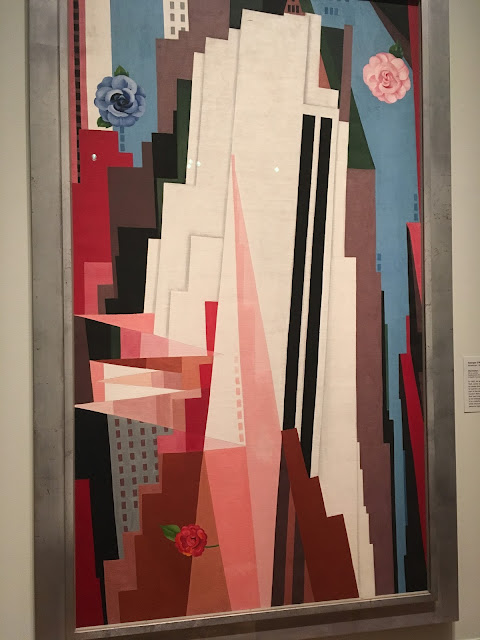 |
| Jack in the Pulpit No. 3, Georgia O'Keeffe, 1930. |
Hello all! This past weekend, I went to an art museum for the first time in a while for an amazing art opening. The museum was one of my favorite local museums,
Reynolda House in Winston-Salem. I've mentioned them before and it is a fabulous museum if you are in the Winston-Salem area with a very interesting history. The building itself was the home of the Reynolds family (Reynolds tobacco and a big name down here). The art is art that was collected afterwards but is from the same time period when the Reynolds family was living in the home. Anyways, the exhibition I went to see was
their brand new exhibition on Georgia O'Keeffe. I hadn't really read anything about the exhibition as I wanted to go in with an open mind and I was very pleased by what I saw.
 |
| Manhattan, Georgia O'Keeffe, 1932 |
The exhibition was divided into two main sections and although it included quite a few of O'Keeffe's works, it was more about O'Keeffe as a person than about her works. The entire exhibition discussed O'Keeffe's life chronologically as she went from a teacher to a prominent artist in New York to living in the south west. One of the main reasons I started to study art history was because of the stories behind the works of art as well as the history of the artists. So, I loved learning more about her whole story to better understand her work.
 |
| Blue #2, Georgia O'Keeffe, 1916 |
Going chronologically, the exhibition first explored how O'Keeffe began with sketches and watercolors and worked towards oil paintings. Through this progression, you can see not only how O'Keeffe works through different mediums but also how she manages abstraction and includes that in her work. Some of her earliest work, like the piece above, are completely abstract. She would continue to have abstract pieces throughout her career and would also integrate it into her other work. For me, O'Keeffe is not an abstract artist, but rather someone who utilizes abstraction to extremely simplify a subject and it allowed her to focus on the aspect of a scene that most interested her.
 |
| The Mountain, New Mexico, Georgia O'Keeffe, 1931 |
The other aspect of the exhibition that was not about O'Keeffe's work, was about her as an individual. The exhibition had quite a collection of her clothes, many of which she made herself. They also had a lot of photographs of her. O'Keeffe was photographed hundreds of time throughout her life by her partner, Alfred Stieglitz, as well as other photographers. These portraits are beautiful in themselves but also helped O'Keeffe to define herself as a female artist in New York in the first half of the 20th century.
 |
| Georgia O'Keeffe and Orville Cox, Canyon de Chelly National Monument Arizona, Ansel Adams, 1937 |
The first thing I am going to say about this exhibition is that I really enjoyed it. I feel like I learned a lot about O'Keeffe and came away with a better understanding of her as an artist as a whole. Like with many things though, there is a however. I liked the exhibition, however, it was not what I expected. I would not describe this as an exhibition of Georgia O'Keeffe's work. Instead, I would say that it was an exhibition about O'Keeffe in general. Let me clarify a little bit. This is not a bad thing at all. In fact, I enjoyed the photographs of O'Keeffe almost more than the work. But I do think it is important to know what to expect from this exhibition so you aren't disappointed.
 |
| Georgia in the Car with Hat- I, Tony Vaccaro, 1950 |
So here is what to expect. First of all, you will see some of O'Keeffe's works. None of the large scale pieces she is known for, but some beautiful pieces from throughout her career. Then, you will see some of her clothes. Many of these she made herself and they are incredible with delicate details and stitching. Finally, you will see photographs of O'Keeffe throughout her life from intimate portraits by her partner to official portraits to candid photographs of her.
 |
| Georgia O'Keeffe, 1929, Alfred Stieglitz |
O'Keeffe was not what many would consider a "beautiful woman" but she was absolutely stunning in her portraits and had such a powerful presence. Let me tell you, after this exhibition, I can say without a doubt that O'Keeffe was an incredible woman. She refused to conform to gender standards and did exactly what she wanted with her clothes, her art, and her life. I think I liked this exhibition so much because I feel like I know O'Keeffe now. If you are in the area, I would highly recommend making a stop at Reynold House and I'd love to hear your thoughts! Until next time, XO
Labels: 2017, art, exhibition, O'Keeffe, painting, photography, Reynolda House







